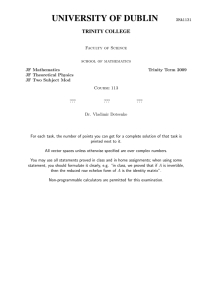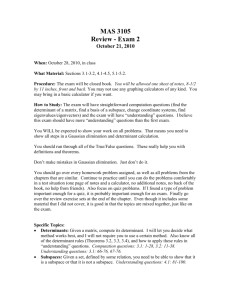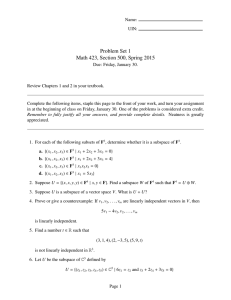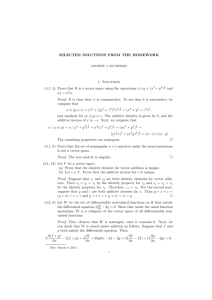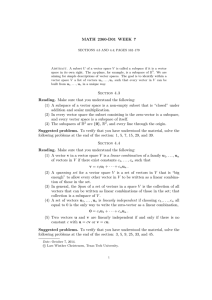DIFFERENTIAL THE MINIMAL SURJECTIVITY TRANSFORMATIONS
advertisement
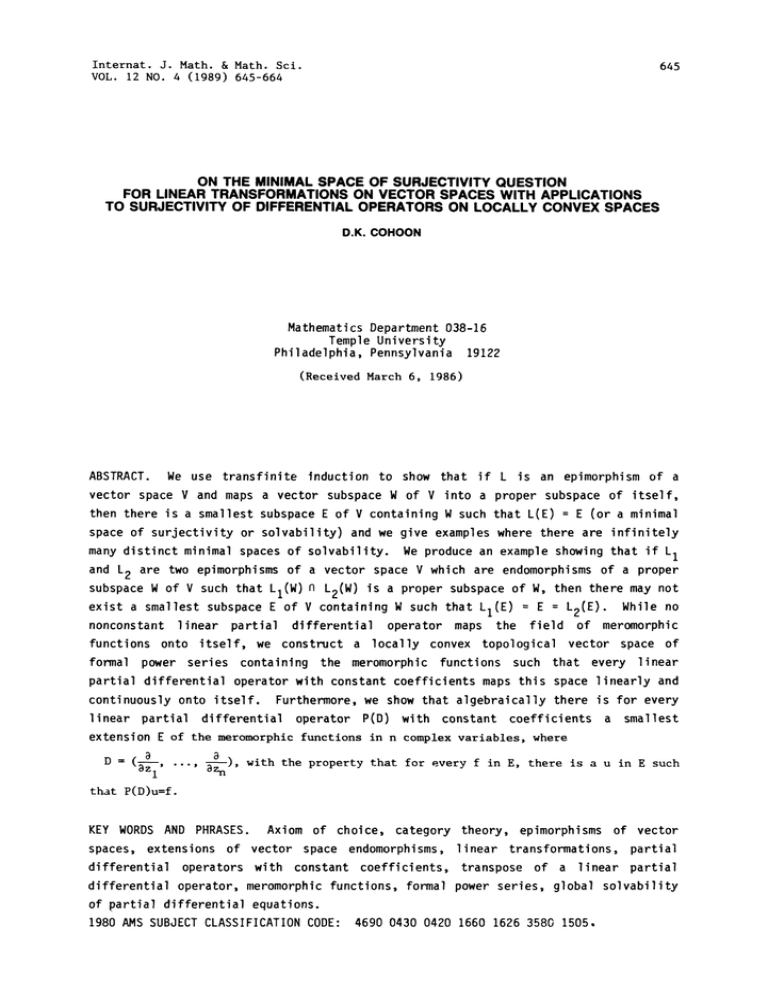
Internat. J. Math. & Math. Sci.
VOL. 12 NO. 4 (1989) 645-664
645
ON THE MINIMAL SPACE OF SURJECTIVITY QUESTION
FOR LINEAR TRANSFORMATIONS ON VECTOR SPACES WITH APPLICATIONS
TO SURJECTIVlTY OF DIFFERENTIAL OPERATORS ON LOCALLY CONVEX SPACES
D.K. COHOON
Mathematics Department 038-16
Temple University
Philadelphia, Pennsylvania 19122
(Received March 6, 1986)
ABSTRACT. We use transfinite induction to show that if L is an epimorphism of a
vector space V and maps a vector subspace W of V into a proper subspace of itself,
then there is a smallest subspace E of V containing W such that L(E)
E (or a minimal
space of surjectivity or solvability) and we give examples where there are infinitely
many distinct minimal spaces of solvability. We produce an example showing that if L 1
and L 2 are two epimorphisms of a vector space V which are endomorphisms of a proper
subspace W of V such that LI(W) n L2(W is a proper subspace of W, then there may not
exist a smallest subspace E of V containing W such that LI(E)
E
L2(E). While no
nonconstant linear partial differential operator maps the field of meromorphic
functions onto itself, we construct a locally convex topological vector space of
formal power series containing the meromorphic functions such that every linear
partial differential operator with constant coefficients maps this space linearly and
continuously onto itself. Furthermore, we show that algebraically there is for every
linear partial differential operator P(D) with constant coefficients a smallest
extension E of the meromorphic functions in n complex variables, where
D
(Bz I
Bzn ), with the property that for every f in E, there is a u in E such
that P(D)u=f.
KEY WORDS AND PHRASES.
Axiom of choice, category
spaces, extensions of vector space endomorphisms,
differential operators with constant coefficients,
differential operator, meromorphic functions, formal
of partial differential equations.
1980 AMS SUBJECT CLASSIFICATION CODE: 4690 0430 0420
theory, epimorphisms of vector
linear transformations, partial
transpose of a linear partial
power series, global solvability
1660 1626 3580 1505.
D.K. COHOON
646
INTRODUCTION.
A straightforward argument using transfinite induction and the axiom of choice
will show that if L is a linear transformation of the vector space V over the field F
onto itself, and W is a subspace of V such that L(W) is a proper subset of W, then
there is a subspace E of V containing W such that L(E)
E and such that if F is any
of
E containing W, then L(F) F. That is to say there is a smallest
proper subspace
extension E of W in which the inhomogeneous equation
1.
Lu
f
(I.I)
E for every f in E.
of this paper we show that there is a vector space V, a subspace W
linear transformations L and L of V onto itself such that
2
1
proper subspace of W and such that if E is any vector space
E, then there is also a
containing W and contained in V such that
F. Thus the minimal
proper subspace F of E containing W such that
space of surjectivity question for families of mappings is not solvable.
If c is a category whose objects are sets, possibly equipped with some structure,
and whose morphisms are mappings between the sets, which preserve the structure, then
we can define the minimal space of surjectivity question as follows. Let C be such a
category. Let V be an object in C and let W be a subobject of V, a subset of V which
has the structure (if any) induced by that of V. Let L be a mapping that is an
has a solution u in
In section two
of V, a pair of
n
is a
LI(W
L2(W
LI(E) L2(E)
LI(F) L2(F)
epimorphism of V in the sense that (e.g. Northcott [1], chapter Ill) V is the unique
and
such that
object in the category of vector spaces and linear transformations
assume
Further
V.
V
of
and
L(V)
LI V are defined where V is the identity mapping
that if U is any subobject of V, then the restriction of L to U defines a morphism of
the category whose range can be any subobject of V containing U. Then we say E is a
solution of the minimal space of surjectivity problem defined by the triple (V,W,L)
E, L(W) is a proper subspace of W, and
satisfying the preceding conditions if L(E)
F. If there is a triple for which
if F is any subspace of E containing W, then L(F)
there is no solution to the minimal space of surjectivity problem we say that for the
category the MSS question has a negative answer. If there is a triple (V,W,L)
satisfying the above conditions for which the MSS problem does not have a unique
answer, we say that there is nonuniqueness for the MSS question for the category.
In section 3 of this paper we show that the MSS question has a positive answer
for the category of vector spaces and linear transformations, but in section 4 we show
that we have nonuniqueness in this category.
In section 5 of this paper we show, for every nonzero linear partial differential
operator with constant coefficients, the existence of a smallest extension of the
meromorphic functions on which the operator is an epimorphism. We do this by
exhibiting a locally convex topolgoical vector space containing the meromorphic
functions on which every linear partial differential operator is an epimorphism and
IvL
applying the results of the previous sections.
MINIMAL SPACE OF SURJECTIVITY QUESTIONS
647
NONEXISTENCE OF A MSS FOR SOME FAMILIES OF EPIMORPHISMS.
It can be shown that if V is a vector space, W is a subspace of V, and L is an
epimorphism of V such that L(W) is a proper subset of W, then there is a subspace E of
V containing W which is minimal with respect to surjectivity in the sense that
L(E) E, but if U is any proper subspace of E containing W, then L(U) does not
contain U.
It seems natural to ask the same question for families of linear
2.
transformations.
MSS Question for Families of Mappings. Le___t V be a vector space. Let W be a
subspace of V. Let F be a family of epimorphisms of V such that L(W)C W for all L in
F and L(W) # W for at.least one L inF. Does there exist a subspace E o__fV containing
W such that L(E)
E for every L in F having the additional property that if U is any
subspace of E containinq W, then L(U) # U for some L in F i__f U E.
The following theorem shows that the MSS question for families of linear
transformations fails in general to have a positive answer even if F contains only two
mappings.
Theorem 2.1. There exists a vector space V, two epimorphisms L and L 2 o__f V,
c W for k
n
is a proper
1, 2, such that
subspace W o__f V such that
subset of W, and having the additional property that if E is any subspace of V
E for k I, 2 then there is a proper subspace U o_f E
containing W such that
U for k 1, 2.
containinq W such that Lk(U)
Proof of Theorem 2.1. Let N denote the set of nonnegative integers. Let Q
denote the set of all nonzero integer powers of the prime q. Let F denote an
arbitrary field. For convenience we introduce the following.
F is a mapping from
Definition 2.1. If S is a set without a topology and v" S
the set S into a field F, then the support of v is defined by the rule,
LI(W) L2(W)
Lk(W)
Lk(E)
supp(V)
{j
S:(j) # O}
We let V 0 denote the vector space of mappings from {0} into the field F. For
every positive integer k we let V k denote the vector space of mappings from Q into F
V k V k denote the projector onto the
whose support is a finite subset of Q. Let P
of
space of functions whose supports are subsets
Nq {q-n
Let T
P(V k)
n
(2.1)
1,2,3
P(V k) be a linear transformation defined by the rule
T(Pk)(q’2n
pk(q -n)
(2.2)
and
T(Pk) (q -(2n-I))
for all positive integers n and all functions
k
0
in V k.
(2.3)
D.K. COHOON
648
-n
Lemma 2.1. If
support is precisely
’ is a function in P(V k) whose,
-2n
-2n
-2n
{q
,
-vt o
q
-n
o r}, then the support of Tv is exactly {q
q 2
q r}.
-2n
were in the support of T. Then by definition
Proof of Lemma 2.1. Suppose q
n must be one of {n 1, n
nr}.
2
As a corollary of Lenna 2.1 we observe that Ker(T) is trivial.
V k V k denote the projector defined by the rule
Let
(q2n) (q2n)
(2.4)
for all positive integers n, and
)v(qm)
(2..,=)
0
if m is an integer that is not equal to 2n for some positive integer n.
Let B
VI VO be defined by
the rule,
(2.6)
BY
where
.(0)
: V(q2n+l)
(2.7)
Define a mapping,
(2.8)
(I-P)V k
S.V k
by the rule,
Sv(q 2n)
Si(q2n-1)
V(q n)
(2.9)
i(q-n)
and
SV(q "n)
(2.10)
0
for all positive integers n.
Let V be the vector space over F defined to be the set of all
(0’ 1’
Vk
is identically zero
where Vk is a member of V k for all nonnegative integers k and
for all but a finite number of nonnegative integers k, and let w denote the space of
k
w
(t0,
1’
O, ...)
(2.11)
649
MINIMAL SPACE OF SURJECTIVITY QUESTIONS
0 is a member of V 0 and
where
Define a mapping L
L1(0’I
’n
-
is a member of
(V I) n Ker(B) where
p _1
(2.12)
V by the rule,
V
(B(TI)’TPI + ]I + 2
"’’)
Define a mapping
I
TPn + n + n+l
(2.13)
Sn + v n+l
(2 14)
V by the rule
L2"V
+
v2
V is an
Lemma 2.2.
V is an epimorphism for k
1,2, and
s omorph sm.
Proof. That each L is an epimorphism is obvious since V is one dimensional and
0
k
or S n,
n+l covers the part of the nth coordinate space not covered by TP n +
+
respectively. Also if each Sv n
n+l is identically zero this implies that each v n
is identically zero, if Vn+l
O, since S’V n
(I-P)V n is an isomorphism.
Now let us construct a space of surjectivity, E, for the operators L and L 2
denote a nonzero member of W. Then there exists a
which contains W. Let (0,0,0
vector
L2-V
Lk’V
]n
(0,i
Vn,O,O,...)
in V
such that
LIT
Since
(-0,0
(Vo’O
0
is in W and E is a vector space we conclude that
,0
(O,Vl, 2
v
Now
LI.
is TP +
(2.15)
,Vn,O,O
Then the nth entry of
suppose that n > 1.
a monomorphism by Lemma
PV
T:PV
is
Since
LI(O, 1,...,vn,O,O
n
n
n
+
are identically zero. Now we know that
and
2.1 we conclude that
+
Vn is identically zero. Thus, the fact that (P+)(Pn_1+lXn+V n) is
+
is
is identically zero. Hence,
identically zero implies that
conclude
we
than
2,
an
larger
n
integer
represents
Since
identically zero.
arbitrary
that the vector v defined in (2.15) is of the form
it
in
E and L lv
n
Pn
n-1
n"
(0,1,0,0
are identically zero.
supp(vl
where 0 < n < n 2 <
and,, consequently,
<
Vl
n
k
<
nk+ 1
# Ker(B).
n
]n-1
Pn-1
v
where P 1 and
Pn-1
q
<
We conclude that
2nk-1
<
k
n r.
Let supp( I)
1,2
,r}
(2.16)
Presumably VO is not identically zero
denote the support of 11" Then we
D.K. COHOON
650
v
E and that there is some v I in E such that
observe that
(O,Vl,O ).
We observe that L 2 is a one-to-one mappirg. Hence
contains only a single
is defined by (2.16), then
element. Observe that if the support of
L2v
Ll({v})
L2v
vI
L)(v)--(0,,,0,0,
(2.17)
0,...)
and
-n
supp(1
Now we observe that since
PI
q
Tn 1
k
1,2,...,r}
(2.18)
,0
(2.19)
that
1’
Lv I
Notice that the support of
k
(O,Tn>1,0
is given by
-2nnl -2nn2 ,...,q n nr}
_2
supp(Tn* 1
q
’q
(2.20)
Now let us look at
L2(O,TnI,0
Observe that the support of
(O,STnI,0
0
STn 1
,0
(2.21)
22nn r -1
(2.22)
is given by
supp(sTn,
q
22nn1-1
,q
Observe that
B(STnI
IO
Thus, we can say that the vector space generated by the elements we know to be in E
has the property that
W
LI(E
c
n
(2.23)
L2(E
Indeed
LI(O,STnI,0
Now the support of
SmsTn@ 1
0,...)
0,...)
(Vo,O,O
is given by
supp (SmSTn I
q
2m(2.2nni-1
q
Now there must be a vector w in E of the fom
w
(0,i,2,
n"’"
2m(2.2nnr-1)
(2.24)
MINIMAL SPACE OF SURJECTIVITY QUESTIONS
651
such that
L l(w)
(O,Vl,O
Since W is a vector space and
(-0,0,0
actually of the form (0,i, 2
0 implies that
Cn
(P+)1
(0,-1,0
,0,...)
,0,...) is in W we may assume that w is
), where
Ker(B) and
Ker(B). But 1
I
W
,0
Thus, we may assume that
(0,0, 2
w
We can show that if n
>
Cn
2, that
(P+-P) 2
is identically zero.
(0,0,2,0,
w
Since
Cn"’"
0 we deduce that
2 1"
(0,1,0,...,0,...),
Thus, we may assume that
0,...)
Hence, we deduce that
(O,O,Vl,0
0,...)
are all contained in E. Thus, the set of functions in E whose coordinate functions
are in P(Ker(B)) or else are modulo a function in P(Ker(B)) a function with support
sufficiently far out forms a proper subspace of E which is mapped onto itself by L 1
and L
2
THE MINIMAL SPACE OF SURJECTIVITY PROBLEM FOR VECTOR
SPACES AND LINEAR TRANSFORMATIONS
Let L be a linear transformation of a vector space V onto itself, and let W be a
subspace of V such that L(W) is a proper subspace of W. The solvability of the MSS
problem for the category of vector spaces and linear transformations is expressed in
3.
the fol owing theorem.
Theorem 3.1. Let L, V, and W be as defined in the introduction to this section.
Then there is a subspace E of V containinq W such that L(E)
E and such that if E 1 is
a proper subspace of E containinq W, then L(E # E
Proof of Theorem 3.1. Let W 1 be a subspace of W such that W
L(W) ) W 1. Let
a
W
be a set consisting of precisely one men)er from
B(W be bases for 1. Let
each of the sets in the family
)
I)
z.
’I(W)
{L-l(w)
w
B(W1)}
The axiom of choice tells us that this set exists.
(3.1)
We need the following result.
D.K. COHOON
652
Lemma 3.1. Let L V V be a linear transformation of V onto itself. Let T be
a linearl>, independent subset of V. I__f s is a set consistin9 of precisely one member
from each of the sets in the family
{L-1(t)
t
(3.2)
T}
then S is a linearly independent set.
v m be an arbitrary finite subset ofs. Let c 1,
Proof of Lemma 3.1. Let v
+
+
+
0 implies
c be scalars. Then
0.
ClV +
m
m
But {L(v
is an m-element subset of T and is, therefore, linearly
c
c2
0.
independent. Hence, c
m
Lemma 3.2. Let L, T, and S be as defined in Lemma 3.1. If [9] and Is] denote
and %, r.esp.e.ctively, and if B([S]) is a basis for
the vector spaces generated by
IS], then L(B[S] is a bases for [7].
u
be an m-element subset of B([%]). Write
Proof of Lemma 3.2. Let {u
L(Vm)}
I)
1= a(k’j)Vk
uj
2
Vp}
CmL(Vm)
m}
I
P
where {v 1,v
ciL(v 1)
CmV
(J
m)
I,
(3.3)
is a p-element subset of % and the matrix
a(1,1)
a(l,m)
(3.4)
A
a(p,1)
a(p,m)
is a ene-to-one linear transformation from m-dimensional space to p-dimensional space.
Then L is a linear implies
P
k-- a(k’j)L(Vk) (j
L(uj)
m)
1,
(.5)
Now suppose that we had
m
j=l
cjL(uj)
(3.6)
0
Then interchanging summation signs we deduce from combining 3.6 and 3.5 that
p
m
(1"= a(k’j)cj) L(vk)
0
(3.7)
But Lemma 3.1 implies that
m
]
j:l
for k
1,2
implies that
p.
a (k,j) cj
0
(3 8)
But the fact that the matrix A defined by 3.4 is one-to-one
MINIMAL SPACE OF SURJECTIVITY QUESTIONS
co
c
653
r
c
(3 a)
Hence, the fact that (3.6) implies (3.9) for all m-element subsets {u
u m} of
B([S]) tells us that L(B[S]) is a linearly independent set. To see that L(B[S])
generates [T] we let L(v) denote an arbitrary element of T, where v
S. Then there
u in B[S] such that
exist u I,
m
+
+
ClU
(3.10)
v
CmU m
By linearity of L and (3.10) we see that L(v) is a linear combination of a finite
number of elements in L(B[S]).
Let U
W and let E be the vector space generated by (U
is an image of the choice function on the family of sets
may define
I) and U 1, where (U 1)
{L-1(t)’t B(W1 )}" Then we
E
U
Q
[(U I)]
where [S] denotes the vector space generated by S for all subsets S of the vector
space V.
Lemma 3.3. uppose L is a linear transformation of V into itself and U is a
is a proper subspace of U I. Suppose E(U I) is the set
subspace of V such that L(U
obtained by taking one member from each set in.the family
I)
{L-l(t)
where U
L(U I)
(
W I.
t e
(3.11)
B(WI)}
Define
E
U1
$
(3.12)
[E(U1)
Then E I is a proper subspace of E 1 containinq U
implies that L(E 1) does not contain
UI"
I(E I)
[(UI)].
must
Then
Proof of Lemma 3.3. Let 71 be a projection of E onto
that
the
fact
be a proper subspace of
since the definition of direct sum and
1
E is a proper subspace of E 1 containing U implies
[E(U1)]
E1
U1
I(E I)
(3.13)
B(I(E1)),
I(EI).
I(u1).
a basis for
We denote by EI(u I) a basis for [(UI)] which contains
)) is a basis for W 1. Since I(E is a proper
By Lema 3.2 we know that
For
must be a proper subset of
subspace of [(UI)], it follows that
then we would have
were equal to
if
B(,I(E1))
L(’I(u1
B(I(EI))
Zl(U1),
I(E 1) [B(I(E1)] [1(UI)
I(E I)
which contradicts the supposition that
(3.14) and the definition of 71 imply that
1)
(3.14)
[(UI)
is a proper subspace of
[(U1)].
Thus,
D.K. COHOON
654
L(E I)
L(U I)
[(I(EI)),
Q
I)
(3.15)
L(U1)Q
and consequently that L(E
is a proper subspace
W 1 U 1.
Hence, L(E does not contain U I. We use transfinite induction to construct for
every ordinal a less than 6 + I, where 6 is the ordinality of a basis for V, a set E
which is minimal with respect to the property that
1)
Us
W
(u{Ey
-y < }
c
L(E)
(3.16)
and
u{Ey
y < a}
Ea
c
(3.17)
in the sense that if
W
c
E
(3.18)
E
I)
then L(E
does not contain U
We have constructed E for
1. Thus, we suppose
that E has been constructed for all B < a. Then define U as in (3.16). It is clear
that
is a vector space, since W and each
is a vector space and y1 <
Y2 implies
Let W be a subspace of V such that
E
Y2
Us
Let
Ey
B(W)
W:.
(U)
Let
be a basis for
one element frn each set in the family
{L-I(w)
We let
Es
be defined to be the set obtained by taking
w
(3.20)
B(W)}
Us and(U).
be the vector space generated by
Then the Lemmas 3.1, 3.2 and
the previous argument show that if E satisfies (3.18), then L(E
E
Since
E
But the
L(V) V, it is clear that there is some ordinal s O such that
1)
L(O
ordinals are well ordered.
1.
SO
Thus, we may suppose
min(y
(3.21)
L(Ey) Ey}
Indeed, it is easy to see that B is the first infinite ordinal.
The following lemma gives important information about the space E
BEB.
Lemma 3.4. l__f B is defined bj (3.21), then UB
Proof of Lemma 3.4. Suppose U # EB. Then L(U would be a proper subspace of
B
UB. It is easy to show by transfinite induction that L(U)C
for every ordinal s.
Then we can write
B)
U
UB
L(UB)
WB
(3.22)
655
MINIMAL SPACE OF SURJECTIVITY QUESTIONS
letB(WB)
B)
Then we would
be a basis for W and letE(U
B
member from each set in the family,
{L-l(w)
be the set consisting of one
w B(W
(3.23)
B)}
Then E is the vector space generated U and
B
B
contradicts the supposition that L(E
Lemma 3.5. For every ordinal
less than 5 +
E(UB)
B)
and clearly L(E
c
B)
U
let W
UB.
This
let
y < }
(3.24)
U L(U) O W,
(3.25)
{Ey"
be a subspace of V such that
B(W)
let
be a basis for W
from each set in the famil),
let
E(U)
be a set consistinq, of preciseljl one element
{L’I(w)
B(W)}
(3.26)
[(U)]
(3.27)
w
and let
x
V/
be a projector of V onto the vector space
[(U)]
[(U)] n U
generated by
(U).
Then
(3.28)
{0}
and for every, vector v in V
v
w
+
(v) (1<
<
(3.29)
a + 1)
where w is a member of W.
n
then
Proof of Lemma 3.5. To prove (3.28) note that if v
n
+
in
{0}. Thus, v
L(v)
CmVm for some elements v 1,
ClV 1 +
subset
of
m-element
an
is
c
and
But
some
c
scalars
(U)
1,
m.
0
a basis for W and is therefore a linearly independent set. Hence, L(v)
< B implies
O. In other words (3.28) is valid. Next we show that
implies v
{0}. Now
[E(U)]
L(U) We
U
Vm
{L(Vl),...,L(Vm)}
B(W)
(V)F B(V)
[E(U)] c Ec
UB
(3.30)
U n [(UB)]
B
{0}
(3.31)
and by (3.28)
D.K. COHOON
656
n
{0} if
and B are
Combining (3.30) and (3.31) we deduce that
ordinalm and < B. Then (3.29) is an immediate consequence of the fact that
[E(U)]
v
[E(UB)]
w (R) ((R)Yl. [ (u)](I_<
a + ))
(3.32)
Proof of Theorem 3.1. Let E be a proper subset of
which contains W, where
n
is defined by (3.21). Then E
E
E # EB. Thus, we deduce that
B
El F Ey # Ey}
{y
(3.33) enable us to define
The well ordering property and
E n E # E_}
Y
min{y
From the fact thaty
< a
implies E n E
Y
is a subspace of E
Y
y>-a Y
where
(El)):
is the projection of V onto U
E implies there is a u
u
E
E implies v
EI
In order that L(E I)
Thus, Lemma 3.5 implies
(I-)(E 1)
(I-)(E 1)
U and a v
eI
But e
(3.34).
Furthermore,
E Ic U
But e
(3.35)
U
if a is defined by
(0
(3.34)
E we deduce that
U n E
om that U
that
(3.33)
#
(3.36)
(I-)(E 1)
such that
u + v
Thus, from (3.36) we deduce that
U=e ((I-)(E 1) C E 1)
E 1 we must have in particular that
(3.37)
UC
L(E 1). But
U: L(U) L([E(U)])
(3.38)
Now (I-)(El)) n E 1 is a proper subspace of (I)(V). We want to show that L(E 1)
Then L(E I) n
Suppose L(E I) did contain
could not possibly contain
L(EI).
a
Then each set in
be
basis
L(U)
T
U. LetB(l)
U.
U.
for. ThenB(T)c
U
the family
{L-I(w) n
EI
w
B($1)}
(3.39)
657
MINIMAL SPACE OF SURJECTIVITY QUESTIONS
EI(u be a set consisting of one member from each set in the
[EI(u ] El E V Let y be an ordinal ntunber larger than
L([EI(u s )]) c U s and L([’(UI y )]) n U s {0}. Thus, [E(U y )] n [EI(u s )]
must be nonempty. Let
family (3.39). Then
herefore
Thus, E’c E
{0} for all ordinals y
El(u
Thus, v
[EI(u
)]
E
c
B
(O][E (U)]
E
E6
implies that
B)
(3.40)
)] implies
v=v+ (vy_ ,<
L(v-v
s < y
(3.1)
)
<
U and
L((R)v,
< y <
B)
0
(3.42)
L((R)v,s
< y <
B)
Us
(3.43)
or el se
U
But since L(v-v
U
it follows that (3.43) is impossible. Hence, L(v-v
But L is one-to-one on each of the subspaces [E (U)] and is consequently one-to-one
Y
on their direct sum. Thus, v
0 for all ordinals y such that s < y < B, where the
Y
is a subspace of
v y are defined by (3.41). Hence v v s This implies that
(U)]
s
E and since
)] U
{0} is consequently a subspace of [E(U )]. Sut this
would imply that
[El
[EI(u
U
is a subspace of E
[EI(u
)]
with the property that U
E n E
c
L(U
[EI(u
)]).
This implies by
Lema 3.2 that
U
Hence, E n E
E
$
[El(us)]
which contradicts
U
[E(U )]
(3.34).
NONUNIQUENESS OF THE MSS PROBLEM FOR THE CATEGORY
OF VECTOR SPACES AND LINEAR TRANSFORMATIONS
In this section we prove that if V is a vector space with a subspace W and L is
an epimorphism of V which maps W into a proper subspace of itself, then there does not
E and L(E I) #
necessarily exist a unique subspace E of V containing W such that L(E)
1
1
E for all proper subspaces E of E containing W. We also define the semigroup
s(V, L, W) of endomorphisms of V which commute with L and leave W fixed.
Theorem 4.1. Le___t F be a field. Then there exists a pair of vector spaces V and
W such that both V an___d W have countable dimension, with W being a subspace of V, such
that there exists a linear transformation L o__f V onto itself which maps W into but not
onto itself. Furthermore, V, W, and L described above can be constructed in such a
4.
D.K. COHOON
658
way that there exists a sequence of spaces {V ’m’{
V2Jl
N} such that V
m
V ’0’{
V ’1’{
W, L maps each V mjl linearly onto itself, and
V (m)
(4.1)
W
m=0
A} of V
In addition there exists an uncountable family of subspaces {E
containing W such that L maps each E linearly onto itself and such that if E Is a
subspace of V satisfyin9
W
1)
is not equal to E
suriectivitj E so that if
then L(E
El
E
1
n E
(4.2)
E
c
we may construct the minimal spaces of
Furthermore
=2 then
I
if we ask
c
(4.3)
W
2
onl), that A be countable.
Proof. Let V denote the set of all functions from N
1,2,3,4
vanish for almost all members of N for
{0,1,2
Let
V2
V
V
x
V3
into F which
(4.4)
V
Let
V
W
where O is the zero element of V
{0_}
x
Let
1,2
for
(4.5)
{0_}
(4.6)
be a bijection.
Define
L 1(v)
LI"V
V by the rule,
(X2Nv,O,O
((v(0),0,v(2),0,v(4),0
(4.7)
),0,0
Define
V
L2:V 2
by the rule,
L2(v
((o,
]
v(y(o,n)),
o, ] v(y(,n)),o
n=O
where y is defined by (4.6).
n=O
Define
L3"V 3
V by the rule
),o,o
(4.8)
659
MINIMAL SPACE OF SURJECTIVITY UESTIONS
L3(v)
(4.9)
(_O,v,_O,O_
If m is an integer larger than three, define L Vm/ V by the rule,
m
L m" (V)
(0
(4.10)
O,v,O,O
/
/
(m-2) nd mth
position position
Define L-V/ V by the rule,
L(v (1) v (2)
L v (i)
..)
(4 11)
i=1
Then L maps V linearly onto itself and L maps W linearly into, but not onto, itself.
De f ne
v m)
v
{1,2,3
where for each
(4.
},
V! m)
{v’J
F
v(n)
0
n
for
<
We first show that L’V (m)+ V (m) is a linear mapping of V (m) onto itself.
((v(O),v(1),v(2)
(4.13)
m}
Let
),v (2) ,v(3),...)
(4.14)
y(n,k)
(4.15)
denote an arbitrary member of V (m)
Let
where
Y
Pn
(n’mn)’
mn
inf{k V
>
m}
Define
w(1)(2n)
v(n) for n V
and define
w(1)(2n+1)
for n N.
0
Define
w(2)(P n)
v(2n+l) for n
N
and defi ne
w(2){k)
Define
0 if k
{Po,P1,P2
}.
D.K. COHOON
660
w
()= v ()
v (k)
for
and
w (k+l)
k
2,3
Then
L(w(1),w(2),w (3)
(v v (2) v (3)
which shows that L maps V (m) linearly onto itself.
projection.
Lemma 4.1. We may write
E
2E
1E
Let
(4 16)
k’V
V k be the natural
3E
The proof of Lemma 4.1 is immediate. Let E
Note that E 2
,k E for k 1,2
k
and hence every E must be infinite dimensional, since by hypothesis E
V 1. The
k
proof we have just repeated shows that if we just require that supp(E2), the support
of the functions in E 2, satisfy supp(E
N {y(n,O), y(n,l), y(n,2)
for every
2)
n, and take E k
E 2 for all k
3,4,5
Also E will be minimal provided that
suppE 2
F
then L will map E linearly onto itself.
{y(n,O), y(n,1), y(n,2)
(4.17)
has just one element in it for every n
v. There are clearly an uncountable number
of ways of choosing E so that the set (4.17) has just one element in it for every
2
n J. Also, the number of ways of choosing E 2 so that condition (4.2) satisfied is
at most countable since for each integer n it must be true that
supp(2El
F
{y(n,O), y(n,l)
is not equal to
supp(2E2
F {y(n,O), y(n,1)
Definition 4.1. Le__t L be an epimorphism of a vector space V which has a subspace
W with the propert}, that L(W) .is a..prop.er subspace of itself. Le.__t 7(V,L,W) be the
s. emi-group of all endomorphisms of V which commute with L and leave elements of W
fixed.
Theorem 4.2. If L, V, and W satisfy the conditions of Definition 4.1 then
S(V,L,W) contains only one element if and only if E is a proper subspace of V
containing W .implies L(E)
E.
Proof. Suppose E were a subspace of V containing W. Let us write V Ker(L)( F
and write E
Let B() be a basis for
and let B(F) be a basis for
Ker(L) n E (
F containing B(). Let B(Ker(L)) be a basis for Ker(L) containing B(Ker(L) n E), a
basis for Ker(L)n E. Then each v in V may be written as
.
,
MINIMAL SPACE OF SURJECTIVITY QUESTIONS
v
alw
+
+
+
+
clu I
+ b
apWp
+
lWl
CrGr + dlU
+
+
+
661
bqWq
+
(4.18)
dsU s
where
{I
{w
,p}
Wq} c
{
B(Ker(L) n E)
c
(4.19)
B(Ker(L) n E)
B(Ker(L))
,r
(4.20)
()
(4.21)
and
{Ul,
u s}
c
B(F)
(4.22)
Then define
(v)
al 1 +
+
We deduce from the definition (4.23) of
L((v))
cIL(G I)
app + c1 1 +
+
Cr r
and the fact that L(E)
+
+
CrL(r)
(L(v))
(4.23)
E, that
(4.24)
we have constructed belongs to S(V,L,W). Conversely, if
Thus, the projector
belongs to S(V,L,W) then E (V) satisfies L(E)
L((V)) (L(V)) E. It is clear
that the identity transformation
belongs to (V,L,W). From our construction it is
clear that if E is a proper subspace of V such that L(E)
E, then the projector we
have constructed is distinct from the identity. This completes the proof of the
Theorem.
SURJECTIVITY OF DIFFERENTIAL OPERATORS ON LOCALLY CONVEX
SPACES CONTAINING THE MEROMORPHIC FUNCTIONS
Let B(C n) denote the meromorphic functions of n complex variables. We construct
a special locally-convex space E n) containing B(C n) such that every nontrivial linear
partial differential operator with n independent variables and constant coefficients
maps E {nl continuously onto itself.
For each j {1,...,n} and for each u(X) C[[X I,
Xn]] define
5.
Tju(X)
Let
F(n)=En) (exterior direct sum), where
I
where
u(X 1,...,xj_ 1,1-Xj,Xj+ I
{0,I}
{0,I}
,Xn)
(5.1)
y runs through the set /, where
(n factors),
(5.2)
D.K. COHOON
662
E
n)
Ey(n)
C[[X
,Xn]]
TYn C[[X
TY1
n
O
X n ]]
(5.3)
and we agree that T
the identity map on C[[X 1,.
These spaces of formal
power series are equipped with the usual locally-convex topology of simple convergence
of coefficients.
(n) is isomorphic to the space
Proposition I. The dual space of E
C[TY1 X
1,...,Tnnxn
,Xn]]
of polynomials.
Furthermore, E (n) is a reflexive Frechet space for
Y
all y i__n %, where _T is liven by (5.2).
X
Proof. It is well-known (e.g. Treves [2], page 266) that [ n) and C[X
are duals of one another. But if E’c E, where E is a topological vector space, and
J E F is an isomorphism then F’
J(E’). Furthermore, if E is a Frechet space, F
is a locally convex space and J
E F is a topological isomporphism, then F is also
a Frechet space.
and a
X
Definition 1. The duality bracket between a po..lynomial P i_n C[X
n]
n]
Xn]]
formal power series u i__n C[[X
<P u>
n
(-[)
is given by
[(B/BX)
The duality
between a polynomial
series v in E nj is given by
bracketr
<Qy,Vy> ] n (T)
P(X)]x:o[(B/@X)u(X)]x=o
Qy
[(@/@x)
in the dual of E
Qy]x:y
[(@/@x)
’n’Y
(5.4)
and a formal power
(5.5)
Vy]x=Y
It is easy to see that if
P(B/BX)
and u
En),
-]’n (II!)[(@I@X)P(X)]x:y (@/@X)
(5.6)
then
<P,u>
[P()/@X)u]xi=Y
{I
(5.7)
n}
It is similarly easy to check that if
Qy(@/BX)
E(n)
and v
]n (1/!)[(@IBX)TYQy(X)]x=y (B/BX)
then
<Qy, vy> [Qy (@/ X) Vy]x
:Y
{1
in
C(R n)
(5.9)
,n}
By E. Borel’s Theorem (e.g. Treves [3], Theorem 18.1) if u belongs to E
is a
(5.8)
n),
such that the coefficients of the Taylor series expansion for
there
about
663
MINIMAL SPACE OF SURJECTIVITY QUESTIONS
X (0)
(0
0) are identical to the coefficients of u.
<P,u>
Thus, we may rewrite (7) as
<P(-BIBX)6,>
(5.10)
where 6 is the Dirac delta function. Again by E. Borel’s Theorem (e.g. Treves [3],
Theorem 18.1) there is for every
in (n) a Oy in C (pn) such that the coefficients
vy
Ey
o(J)
O
of the Taylor series expansion of
about y are equal to the corresponding
coefficients of vj, where X (Y)
y. Thus, we may rewrite (5.9) as
<Qy(-/X)(X-X(Y)),y>
<Qy,Vy>
(5.11)
L(B/BX) denote a linear partial differential operator with constant
coefficients. We can use m (5.10) and (5.11) to determine the action to tL on En)"
U
and E j)’ for all y in I, where I is given by (5.2). It is well known that
Let L
Y
<P,L(alBX)u>
<P(-alBX),L(alaX)>
(5.12)
implies that the transpose of L is one-to-one, since it follows that
tLP(X)
Similarly, if
Qy
L(X)P(X)
(n)
E
then
(5.13)
<Qy,L(/BX)u> <L(-/@X)P(-@/BX),y>
(5.14)
E (n) and v
Y
Thus, for every polynomial
Y
Y
Qy in E(n),
Y
tLQ Y L(T Y1
X
TYn
n
Xn)QY
(5.5)
for all y in I. By Theorem 28.1 of Treves [3] it follows that L(X)E nj’ is a closed
Y
subspace of E nj’ for every y in I. This, in view of a classical theorem due
Y
essentially to S. Banach, which states that a continuous linear map L of one Frechet
space E into another Frechet space F is an epimorphism if and only if its transpose is
one-to-one and weakly closed, implies that L
E (n) E (n) is an isomorphism for all y
in/.
Let V (n) be the subspace of E (n) consisting of all members of E (n) which may be
identified with a member of
n)
E,
y’y
]
(exterior direct sum).
c V (n)
since L(V
epimorphism of
Y
Y
Y
R(C n) can be identified with a subspace of
(n))
Ey(n)/v(n)
E (n)
ER)IvR)
Then L is still an
Note that V (n) is closed
Y
ER)Iv n),
E
n)
The space
(5.16)
Thus, R(C n) can, when regarded as a vector space, be given a locally convex topology
in a natural way, namely the one induced by E n).
C n-1 be defined
Let f(z I
z be a member of R(cn). Let j’C n
Zn)/g(z
by the rule,
n)
D.K. COHOON
664
(z
j(z)
Let us write
.
g(z I,
z n)
go(j(z)) + zjgl(j(z))
Let r be the smallest positive integer such that
=1
(5.17)
Zn)
Zj_l,Zj+
+
+
Zgr(j(z))
gr(j(z))
# O.
+
Then
k hk(j(z))zj
k
0
ho(j(z))
r
+
+
zj
hr_l( J (z))
zj
+
]
k=r
h k (7 j
(z))z -r
(5.18)
of/?(cn-1).
hk(j(z)),
where the functions
are members
Proceeding in this manner we
deduce that each representative of a member of R(C n) is contained in
TYc[[X
y
Xn]]
(exterior direct sum) or eliminating redundancy that
R(C n)
c
YC[[X]]/ n)
C[[X]] ( T
y
(5.19)
Y #0
REFERENCES
[1] Northcott, D. G., Homoloical AIBeb.ra, Cambridge- University Press, (1960).
[2] Tr’eves, J. F., Linear Partial Differential Equations with Constant Coefficients,
New York-
Gordon and Breach, (i966).
[3] Treves, J. F., Topological Vector Spaces Distributions and Kernels, New York"
Academic Press, (1967).
[4] Treves, J. F., Applications of Distributions to PDE Theory, American Math.
Monthly, 77, (1970), 241-248.


